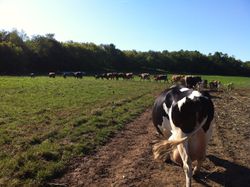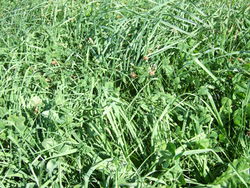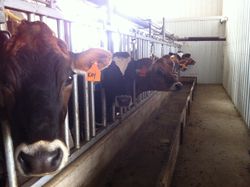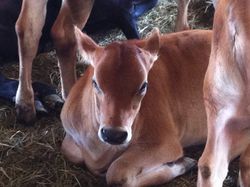Raw Milk
|
This article is part of the Food Rights Network, a project of the Center for Media and Democracy. Find out more here. |
Raw Milk is milk in its unprocessed form, that has not been pasteurized or homogenized. More information is available on the Raw Milk Portal. Consumed for thousands of years, it wasn't until the late 1800's that pasteurization was introduced, and the first law requiring pasteurization wasn't passed until 1908, in Chicago.[1]
In recent years, the production and consumption of raw milk has again become a topic of debate, with many advocates promoting superior nutrition as compared to regular milk and others warning against it due to an increased risk of pathogen exposure.
Raw milk, however, doesn't make the list of most dangerous foods based on largest and deadliest foodborne illness outbreaks published by the Center for Science in the Public Interest (CSPI) in 2009,[2] and dozens of studies reviewed in May 2013 by independent health researcher Nadine Ijaz for the British Columbia Center for Disease Control suggest that raw milk is actually a low-risk food.[3][4]
Pasteurized milk, on the other hand, sickened 1,644 people in one 2006 outbreak of Campylobacter jejuni and killed three in a June 2007 outbreak of Listeria monocytogenes, according to data from the Centers for Disease Control and Prevention (CDC).[5]
Contents
Raw vs. Pasteurized Milk
On July 18, 2012, the deputy director of the CDC's Division of Foodborne, Waterborne, and Environmental Diseases, Dr. Robert Tauxe, sent a letter to state health officials outlining the dangers of raw milk consumption and urging state lawmakers to consider further regulating raw milk sales. "Pasteurization is the only way to ensure that fluid milk products do not contain harmful bacteria," according to the letter.[6]
This statement is misleading because it ignores the possibility of producing milk that is uncontaminated by those harmful bacteria in the first place, by keeping cows on pasture rather than confined in feedlot operations standing in their own manure, by rigorously observing and maintaining the health of the herd and of individual cows through modern testing as well as close physical observation, and by following accepted dairy hygiene practices during milking, collection, cooling, and bottling. See #History of Milk Pasteurization in the U.S. below for a discussion of the history of certifying clean, uncontaminated milk rather than pasteurizing milk of questionable hygiene.
According to the Raw Milk Consumer Guide, by Amanda Rose of Traditional Foods, customers interested in drinking clean raw milk should develop a relationship with and ask questions of their dairy farmer. The guide specifies different questions based on the size of the dairy because, as Rose says, "there is a lot of equipment involved in keeping a clean and safe operation, from a sink in the milk house (or, better yet, two sinks) to a milk house plumbed with hot water for cleaning tanks. . . . This is not to say that you should not buy from a three-animal operation, but it is to inform you of the difference in safety measures you will find there." The questions she recommends, based on size, are:[7]
Basic Questions for All Raw Milk Producers
- "Is your feed certified organic?” If no, “Do your cows get genetically modified (GM) grains or other feed?”
- Feed is extremely expensive these days, particularly organic feed. Your farmer may not use organic feed, but if he or she does not, you should know that it is difficult these days to source non-GM grains that are not certified organic. If your farmer does not feed organic feed but says it is not GM, he or she is likely to have quite a story about how they get it. It is worthy of asking about it. If the farmer does not appear to have a story, do not assume that the non-organic feed is GMO-free.
- “Do your cows receive soy in their diet?”
- Many raw milk consumers are concerned about the increase in soy in animal foods. Ask your farmer this question. If you do not receive a specific answer, do not assume the animal’s diet is soy-free. It is difficult to find a pre-mixed feed without soy.
- “Do you give your cows antibiotics?” If not, “How do you care for sick cows?” If yes, “Do you cull the cow from the herd if she needs antibiotics?”
- In organic standards, cows have to be culled if they receive antibiotics. A non-organic farmer may allow the cow to rest and recover for some time before she is integrated back into the milk herd. This is not necessarily a health and safety issue for the milk. A bigger issue is routine use of low dose antibiotics, a practice not used in the [organic] dairy industry.
- In this economy, many farmers are probably using conventional feed. An honest and direct answer is best.[8]
Grass Feeding
According to a January 2009 article in Clinical Infectious Diseases prepared by the Weston A. Price Foundation, "raising cows on fresh, open pasture can minimize the risk of contamination by boosting the natural immunity of the animals" and "raising cows on fresh, open pasture is a better way than pasteurization to make milk safe" in part because "feeding fresh, high-quality pasture is the most
important means of preventing subclinical mastitis. . . . [D]airy farmers engaged in pasture feeding routinely get somatic cell counts well below the level that would indicate subclinical mastitis in the herd." This is due in part to Vitamin E: "Vitamin E intakes of lactating cows on pasture can be four to five times higher than the average intake in the United States and over ten times the minimum intake recommended by the National Research Council (NRC)."[9] In addition, the top "limiting factor . . . for survival of [manure-born] pathogens in the environment" is sunlight, according to the School of Veterinary Medicine at the University of California Davis.[10]
According to the Raw Milk Consumer Guide, "to determine how much fresh grass cows actually receive, you can ask the farmer these questions:"
- “What portion of your cows’ diet comes from grain?”
- “What portion from dry grass and legumes?” (e.g., hay, including alfalfa)
- “What portion comes from pasture?”
- The answer to these questions should vary by the season and that, in itself, should not be a red flag for consumers. In fact, a farmer who is trying to educate his or her consumer would likely clarify, “In the spring, pasture grass makes up 80% of the diet of my herd but in the summer, it is only 20%.” You will probably find that the flavor of the milk will change over these periods.[8]
In addition, organic milk -- which under national organic standards is from cows that are given access to pasture (although these standards may not be well-enforced in some cases) -- was found in a 2013 study by Washington State University research Charles Benbrook (who is also on the Science Advisory Board of the Organic Center) to contain "25% less ω-6 fatty acids and 62% more ω-3 fatty acids than conventional milk, yielding a 2.5-fold higher ω-6/ω-3 ratio in conventional compared to organic milk (5.77 vs. 2.28)." It also found that "dairy products supply far more α-linolenic acid than seafoods, about one-third as much eicosapentaenoic acid, and slightly more docosapentaenoic acid, but negligible docosahexaenoic acid."[11]
Large Dairy (30+ cows)
- Do you test for pathogens? How often?
- How did you respond after your last bad pathogen test?
- Rose says: "I would ask about their pathogen testing protocol. They are big enough that they can afford to test. Ask how regularly they test and what they do when they get a bad test result back. If they claim to have a perfect record of pathogen tests and they have been in business for a while, I would be hesitant to buy. Bad test results are a fact of life and the best dairies face them and make improvements accordingly."[12]
Medium Dairy (3+ cows)
- What kind of equipment do you use for milking? How often is it cleaned?
- How quickly do you cool down the milk? How do you keep it cold?
- Rose says: "I would ask first about their milking practices. They are too small to afford regular testing but they are big enough that they should have milking equipment that is sanitized regularly and a milking area that can be cleaned thoroughly. They should be able to cool their milk immediately and keep it cool. At this size, I would consider a muddy floor and dirty milk barn to be warning signs."[12]
Small Dairy (1-2 cows)
- How do you prepare the animal for milking?
- How quickly do you cool down the milk? How do you keep it cold?
- Rose says: "For an 'itty bitty' dairy, you will need to keep your ears open and listen to their story. The dairy is definitely too small to afford testing and probably milks into an open bucket. On the positive side, you will be consuming milk from just a few animals, which is theoretically less risky. On the other hand, their equipment will not be ideal from a food safety point of view. Ask how they milk hygienically and how they cool their milk and keep it cool. The details they provide you should reveal how much care they take. It is not straightforward to milk into a bucket and then cool the milk quickly. They will have a story to tell if they do, and the story will vary by farm."[12]
Raw Milk and Allergies: The "Hygiene Hypothesis"
Dr. Mark Holbreich, an allergy and asthma consultant in Indianapolis, IN, published a study in the June 2012 issue of The Journal of Allergy and Clinical Immunology that echoes the results of several European studies,[13][14] finding that Amish children living in Indiana have a lower prevalence of allergic sensitization than the general public. He notes, "They live primarily an agrarian lifestyle. Many families live on working farms. All Amish families have horses that are used for transportation. A significant percentage drinks raw milk." Comparing the results -- "the exceedingly low level of sensitization of 7.2% among Amish children" -- to those of the European studies, especially the "GABRIELA Study,"[15] the new study concludes, "Although we have not determined specific mechanisms, this study continues to support the effect of early farm exposures and their impact in significantly reducing the prevalence of asthma and allergic sensitization."[16]
One of those early farm exposures is raw milk, or "farm milk," as some European studies call it.[16]
As NPR's "Morning Edition" explained in its coverage of the study, allergies may be on the rise, especially in children, because we're all too clean. Dr. Holbreich told NPR that the low rates of allergies among the Amish may be because the children get exposed very early on to dirty environments, and to a variety of dust and germs. He calls it "the farm effect" -- young kids being frequently in the barn, working with animals, and drinking raw milk -- and says, "We think there's something about milk. That's key, along with exposure to large animals, particularly cows."[17]
An October 2012 review of several epidemiological studies published in The Journal of Allergy and Clinical Immunology concludes, "Raw milk contains many proteins and other constituents that might help in preventing asthma in infants and young children. These findings are highly relevant and could lead to the devel- opment of mildly processed milk products and toddler and infant nutrition, which could become a part of preventive strategies to reduce the incidence of allergic disease."[18]
Others have explained the rise in allergies, except in children who spend lots of time on farms and drink raw milk, as the "hygiene hypothesis":[19][20][21][22] "[W]e're not stimulating a portion of our immune system with bacteria and viral infections the way we used to," says Dr. Hugh Sampson, professor of pediatric allergy and immunology at Mount Sinai School of Medicine in New York. "We don't have the infections that we used to have. We've been immunized against many diseases, so your immune system has not been confronted with many of these different organisms. We've evolved over the centuries having to deal with all these infections and we do have what we call this primitive immune system or the innate immune system that is very much involved in the way we become tolerant to things in our environment. And without these other stimulations, this system may not be operating as it had in the past. . . . We all have about two pounds of bacteria in our gastrointestinal tract, so we live with millions and millions of bacteria, you know, in a very harmonious relationship."[23]
History of Milk Pasteurization in the U.S.
Until the late 1800's, all milk was "raw milk." At that time, milk contaminated with various pathogens, including tuberculosis, started to make people sick, particularly infants.[24] Particularly in New York City, "swill milk," or milk from cows fed distillery waste (who in time became diseased themselves), then contaminated with other substances to improve its appearance and flavor, was said to sicken children and contribute to the mortality of children under five years becoming the largest percentage of the death rate in the city.[25]
In 1886, Franz von Soxhlet suggested the pasteurization of milk for infant nutrition.[26] To that point, pasteurization had been used for wine after Louis Pasteur's proposal in 1868, but was not popular among makers of fine wines, who "had always safeguarded their wines by maintaining cleanliness in their cellars and by carefully following strict methods of manufacture." They found that pasteurized wine acquired a "cooked" taste.[27]
In 1893, private philanthropist Nathan Straus, co-owner of Macy's department stores, began to set up "milk depots" to provide discounted pasteurized milk-- then called "sterilized" milk-- in New York City.[28][24]
At around the same time, Dr. Henry Coit, a physician in Newark, New Jersey, urged the certification of clean, uncontaminated milk by a "Medical Milk Commission" as an alternative to heat treatment.[29]
These two approaches co-existed for some time. In 1944, however, a series of articles began to appear in popular magazines such as Ladies' Home Journal and Reader's Digest," telling fictitious stories about the risks of undulant fever. One of the authors, Dr. Robert Harris, wrote about a town called Crossroads "in one of those states in the Midwest area called the bread basket and milk bowl of America," in which, he said, an epidemic of undulant fever caused by raw milk struck one out of four people in the town. Both the town and the epidemic were fictional, as he later admitted in an interview. In other articles he published both before and afterwards, he also admitted that "Mortality in acute cases of undulant fever was formerly about two percent, but this has been greatly lowered by modern methods."[30]
Milk Homogenization
To prevent cream from rising to the top of milk, which is naturally an emulsion, most milk in the United States is homogenized, forced at high pressure and temperature through small holes. This breaks up the fat globules so that they resist separation, making a product that does not have to be shaken to reincorporate the cream.[31]
Raw Milk Laws in the US
It is currently legal to purchase raw milk in some form in 39 states. Sales are legal in 10 states, legal on farms in 15 states, legal in "herd shares" (in which an individual or family purchases a share of a herd's milk output) in 10 states, and legal as pet food in 4 states.[32] For more, see Raw Milk Laws By State.
Raw Milk is subject to varying degrees of regulation on a state by state basis. Stringent laws exist in most states regarding the sanitation and cleanliness of raw milk production facilities and equipment. The goal is to ensure a safe product for raw milk consumers, less likely to carry pathogens that could affect a non-pasteurized product.[33]
The U.S. Food and Drug Administration has banned interstate sales of raw milk.[34]
Support for Raw Milk
Advocates for raw milk include coalitions of organic food consumers, libertarians, and farm families.[35]
Advocates point to heat-sensitive molecules in milk that can be destroyed through pasteurization, including certain casein proteins, antibodies & immunoglobins and some enzymes.[36] Researchers have also found homogenization to contribute to higher rates of allergies,[31] heart disease and cancer.[37]
Articles and Resources
Related SourceWatch Resources
- Raw Milk Portal
- Dan Brown
- David E. Gumpert
- David J. Hochstetler
- Double O Farms
- E. coli
- Family Farms' Cooperative
- Farm-to-Consumer Legal Defense Fund
- Foodborne Illness
- Forest Grove Dairy
- Gary Oaks
- Grassway Organics
- Gravelwood Farm
- Herdshare
- Judith McGeary
- Local Food and Self-Governance Ordinance
- Mark McAfee
- Mary G. Enig
- Milk Homogenization
- NOFA/Massachusetts
- Organic Pastures Dairy Co.
- Pasteurization
- Portage Prairie Pastured Poultry
- Raw Milk Freedom Riders
- Raw Milk Laws By State
- Raw Milk Raid Timeline
- Rawesome Foods
- Richard Hebron
- Sally Fallon Morell
- Salmonella in Eggs
- San Diego County Crackdown on Raw Milk
- Tucker Adkins Dairy
- Weston A. Price
- Weston A. Price Foundation
- Zinniker Family Farm
Related PRWatch Articles
- Rebekah Wilce, Activists Rally Around Wisconsin Dairy Farmer Facing Criminal Charges, PRWatch.org, March 5, 2012
- Rebekah Wilce, California is Farmer Brown, PRWatch.org, December 12, 2011
- Rebekah Wilce, Raw Milk Freedom Riders Take on Chicago, PRWatch.org, December 9, 2011
- Rebekah Wilce, We Are Farmer Brown, PRWatch.org, December 9, 2011
- Rebekah Wilce, Local Food Ordinances from Maine to California, PRWatch.org, October 10, 2011
- Rebekah Wilce, Wisconsin Judge Rules Against Food Rights, PRWatch.org, October 6, 2011
- Rebekah Wilce, Raw Milk Raids and Court Cases Enter New Territory, PRWatch.org, October 5, 2011
External Resources
- Food & Water Watch's Guide to Milk
- David Gumpert, The Complete Patient blog
- Coalition for Farm Food Freedom, Grassfed On The Hill website
- Weston A. Price Foundation, A Campaign for Real Milk website
- Charles Benbrook, Gillian Butler, Maged A. Latif, Carlo Leifert, and Donald R. Davis, Organic Production Enhances Milk Nutritional Quality by Shifting Fatty Acid Composition: A United States–Wide, 18-Month Study, PLoS ONE 8(12): e82429, December 9, 2013.
References
- ↑ Neal D. Fortin, Food regulation: law, science, policy, and practice (Hoboken: John Wiley & Sons, 2009), p. 13
- ↑ The 10 Riskiest Foods Regulated by the U.S. Food and Drug Administration, Center for Science in the Public Interest, 2009.
- ↑ Nadine Ijaz, MSc, Unpasteurized Milk: Myths and Evidence, British Columbia Center for Disease Control Grand Rounds forum for state of the art research presentation, May 16, 2013.
- ↑ Weston A. Price Foundation, New Studies Confirm: Raw Milk A Low-Risk Food, organizational press release, June 11, 2013.
- ↑ CDC's FOOD Database, Downloaded on October 9, 2011, Data crunched by Jill Richardson.
- ↑ Gretchen Goetz, CDC Asks States To Consider Further Raw Milk Regulation, Food Safety News, July 19, 2012
- ↑ Amanda Rose, Raw Milk Consumer Guide: How to Choose Your Raw Dairy Farmer, Questions to Ask, and Red Flags, Traditional Foods blog, white paper, August 2011
- ↑ 8.0 8.1 Amanda Rose, Raw Milk Consumer Guide, Traditional Foods blog, white paper summary, August 2011
- ↑ Weston A. Price Foundation, "pasture Response to Anti-Raw Milk Article, Clinical Infectious Diseases, January 2009
- ↑ John H. Kirk, DVM, MPVM, Pathogens in Manure, academic reference paper, accessed July 2012
- ↑ Charles Benbrook, Gillian Butler, Maged A. Latif, Carlo Leifert, and Donald R. Davis, Organic Production Enhances Milk Nutritional Quality by Shifting Fatty Acid Composition: A United States–Wide, 18-Month Study, PLoS ONE 8(12): e82429, December 9, 2013.
- ↑ 12.0 12.1 12.2 Emily Ho, Buying Raw Milk? Questions to Ask Your Dairy Farmer, theKitchn blog, interview with Amanda Rose, July 25, 2012
- ↑ Erika von Mutius and Donata Vercelli, "Farm living: effects on childhood asthma and allergy," Nature Reviews (Volume 10, December 2010), p. 861
- ↑ Josef Riedler MD, Charlotte Braun-Fahrländer MD, Waltraud Eder MD, Mynda Schreuer PhD, Marco Waser MSc, Soyoun Maisch MD, David Carr PhD, Rudi Schierl MD, Dennis Nowak MD, Erika von Mutius MD, and the ALEX Study Team, "Exposure to farming in early life and development of asthma and allergy: a cross-sectional survey, The Lancet (Volume 358, Issue 9288, 6 October 2001), pp. 1129 - 1133
- ↑ Loss G, Apprich S, Waser M, Kneifel W, Genuneit J, Buchele G, et al, "The protective effect of farm milk consumption on childhood asthma and atopy: the GABRIELA study," Journal of Allergy and Clinical Immunology (2011;128:766-73), p. 1
- ↑ 16.0 16.1 Mark Holbreich, MD, Jon Genuneit, MD, Juliane Weber, MD, Charlotte Braun-Fahrländer, MD, Marco Waser, PhD, and Erika von Mutius, MD, "Amish children living in northern Indiana have a very low prevalence of allergic sensitization, The Journal of Allergy and Clinical Immunology (Volume 129, Issue 6 , June 2012), pp. 1671-1673
- ↑ Patti Neighmond, "To Sniff Out Childhood Allergies, Researchers Head To The Farm, NPR Morning Edition, June 11, 2012
- ↑ R.J. Joost van Neerven, PhD, Edward F. Knol, PhD, Jeroen M.L. Heck, PhD, and Huub F.J. Savelkoul, PhD, "Which factors in raw cow's milk contribute to protection against allergies?" The Journal of Allergy and Clinical Immunology (Volume 130, Issue 4), pp. 853-858, October 2012. Full text here.
- ↑ Nancy Shute, "Why Getting Grimy As A Child Can Make For A Healthier Life," NPR "Shots" Health Blog, March 23, 2012
- ↑ Torsten Olszak, Dingding An, Sebastian Zeissig, Miguel Pinilla Vera, Julia Richter, Andre Franke, Jonathan N. Glickman, Reiner Siebert, Rebecca M. Baron, Dennis L. Kasper2, and Richard S. Blumberg, "Microbial Exposure During Early Life Has Persistent Effects on Natural Killer T Cell Function," Science (Vol. 336 no. 6080), 27 April 2012, pp. 489-493
- ↑ Whitney Blair Wyckoff, "Why Keeping Little Girls Squeaky Clean Could Make Them Sick," NPR "Shots" Health Blog, February 3, 2011
- ↑ Sharyn Clough, "Gender and the hygiene hypothesis," Social Science & Medicine (Volume 72, Issue 4, February 2011), pp. 486–493
- ↑ Debbie Elliott, Allergies and the Hygiene Hypothesis, NPR "All Things Considered," December 9, 2006
- ↑ 24.0 24.1 Contaminated Milk and Infant Mortality, Lower East Side Tenement Museum, Encyclopedia of Health and Disease website, accessed October 9, 2011
- ↑ Bad Milk, New York Times, April 30, 1874
- ↑ Franz Soxhlet (1886) "Über Kindermilch und Säuglings-Ernährung" (On milk for babies and infant nutrition), Münchener medizinische Wochenschrift (Munich Medical Weekly), Vol. 33, pp. 253, 276
- ↑ Leo A. Loubère, The Red & the White: The History of Wine in France and Italy in the Nineteenth Century (New York: State University of New York Press, 1978), p. 194
- ↑ Pure Milk for the Poor, New York Times, May 16, 1894
- ↑ Paul Gustav Heinemann, Milk (Philadelphia and London: W.B. Saunders Company, 1921), pp. 482-510
- ↑ Ron Schmid, The Rise and Fall of Raw Milk, Green Living Journal (excerpted from The Untold Story of Milk), accessed October 9, 2011
- ↑ 31.0 31.1 Randolph Jonsson, Homogenization: A Closer Look, Raw-Milk-Facts.com website, accessed October 9, 2011
- ↑ US Summary, What's Happening with Real Milk? website, Accessed 4 October 2011
- ↑ Vermont, What's Happening with Real Milk? website, Accessed 4 October 2011
- ↑ 21 CFR § 1240.61, "Mandatory pasteurization for all milk & milk products," United States Code of Federal Regulations, 1987, accessed October 9, 2011
- ↑ Corby Kummer, '"Pasteurization Without Representation," The Atlantic, May 13, 2010
- ↑ Randolph Jonsson, "The Health Benefits of Raw Milk," Raw-Milk-Facts.com website, accessed October 4, 2011
- ↑ Robert Cohen, Homogenized Milk: Rocket Fuel for Cancer, Health101.org website, accessed October 9, 2011




